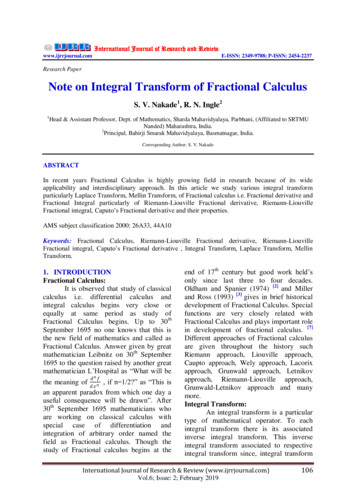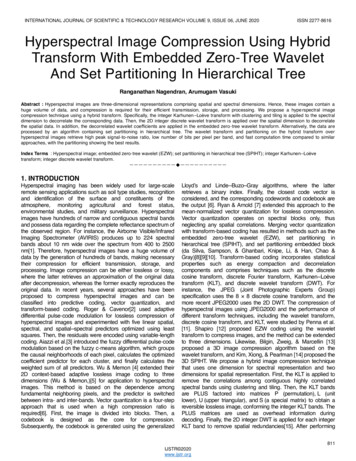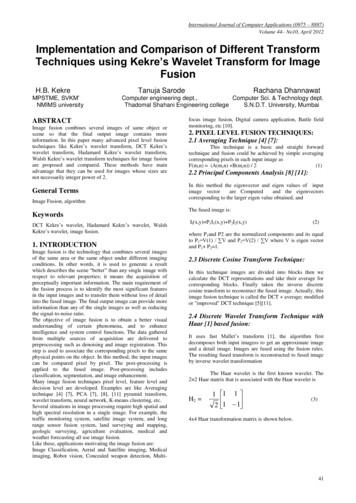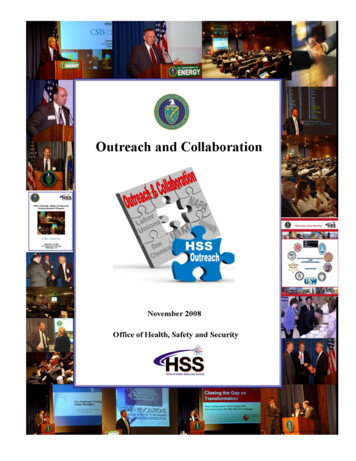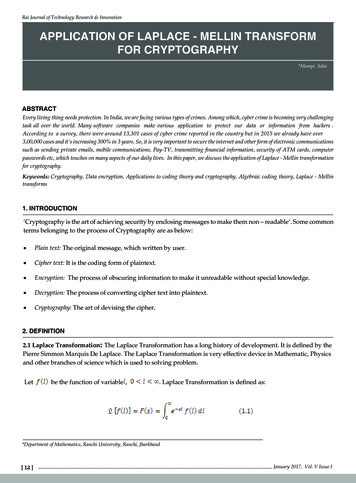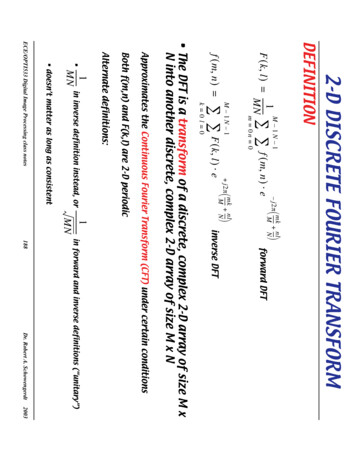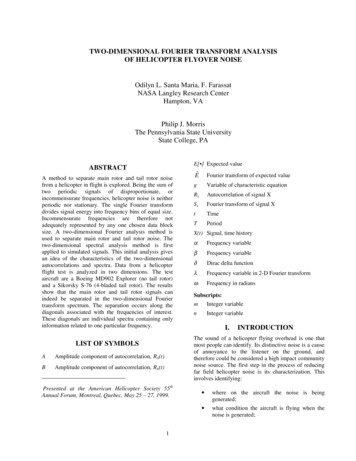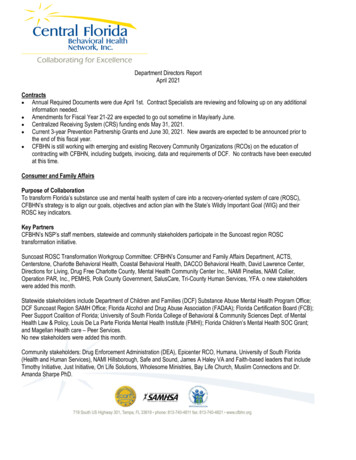
Transcription
Department Directors ReportApril 2021Contracts Annual Required Documents were due April 1st. Contract Specialists are reviewing and following up on any additionalinformation needed. Amendments for Fiscal Year 21-22 are expected to go out sometime in May/early June. Centralized Receiving System (CRS) funding ends May 31, 2021. Current 3-year Prevention Partnership Grants end June 30, 2021. New awards are expected to be announced prior tothe end of this fiscal year. CFBHN is still working with emerging and existing Recovery Community Organizations (RCOs) on the education ofcontracting with CFBHN, including budgets, invoicing, data and requirements of DCF. No contracts have been executedat this time.Consumer and Family AffairsPurpose of CollaborationTo transform Florida’s substance use and mental health system of care into a recovery-oriented system of care (ROSC),CFBHN’s strategy is to align our goals, objectives and action plan with the State’s Wildly Important Goal (WIG) and theirROSC key indicators.Key PartnersCFBHN’s NSP’s staff members, statewide and community stakeholders participate in the Suncoast region ROSCtransformation initiative.Suncoast ROSC Transformation Workgroup Committee: CFBHN’s Consumer and Family Affairs Department, ACTS,Centerstone, Charlotte Behavioral Health, Coastal Behavioral Health, DACCO Behavioral Health, David Lawrence Center,Directions for Living, Drug Free Charlotte County, Mental Health Community Center Inc., NAMI Pinellas, NAMI Collier,Operation PAR, Inc., PEMHS, Polk County Government, SalusCare, Tri-County Human Services, YFA. o new stakeholderswere added this month.Statewide stakeholders include Department of Children and Families (DCF) Substance Abuse Mental Health Program Office;DCF Suncoast Region SAMH Office; Florida Alcohol and Drug Abuse Association (FADAA); Florida Certification Board (FCB);Peer Support Coalition of Florida; University of South Florida College of Behavioral & Community Sciences Dept. of MentalHealth Law & Policy, Louis De La Parte Florida Mental Health Institute (FMHI); Florida Children’s Mental Health SOC Grant;and Magellan Health care – Peer Services.No new stakeholders were added this month.Community stakeholders: Drug Enforcement Administration (DEA), Epicenter RCO, Humana, University of South Florida(Health and Human Services), NAMI Hillsborough, Safe and Sound, James A Haley VA and Faith-based leaders that includeTimothy Initiative, Just Initiative, On Life Solutions, Wholesome Ministries, Bay Life Church, Muslim Connections and Dr.Amanda Sharpe PhD.
Recovery Community Organization (RCO) Development Collaborative: CFBHN, DACCO and Suncoast Region DCF SAMHoffice staff members, American Addiction Centers, DEA, The Phoenix, Timothy Initiative, and Recovery Project FloridaBehavioral Health Association provided through FADAA.New stakeholders: Craig Pickos, Polk County, (emerging RCO).ROSC Status Update Summary CFBHN participated on the States Recovery Management Guidance Document draft. Draft was sent to MEs for review and comment.ROSC Key Indicator Summary Accomplishments and OutcomesA.Promoting Collaborative Service Relationships:1. CFA staff along with other CFBHN staff participated in DCF’s ROSC SOR II Collaborative QI Monitoring Reviewtraining.CFBHN is developing a QI monitoring process for SOR II referred to as ROM. Staff are meeting internally to preparefor site visits and determine scheduling with our NSP’s.2. CFA coordinated virtual Wraparound 101 Trainings for the Suncoast Region stakeholders to assist in the certificationprocess.3. CFA reports quarterly to DCF’s HQ SOC project manager (Mary Schrenker) newly certified Wraparound Facilitatorsand Coaches.One individual from CFBHN became certified as a Wraparound Coach in March.4. Facilitated the SunCoast ROSC Transformation Workgroup.Seven participants attended the February meeting and twelve participants attended the March meeting.B. Community Integration:1. Consumer and Family Affairs (CFA) department offers Recovery-Oriented System of Care(ROSC) technical assistance to the SunCoast regions developing Recovery Community Organizations (RCO) entitiesto educate and encourage the use of recovery concepts and principles.Updates as followsHillsborough County: Hillsborough Recovery Coalition’s website is live and they are working to fill positions on theirboard and are waiting on confirmation on the status of their 501c 3 status. HRC is planning its first Narcan distributionfor the community.
Lee County: As of February, Kimmie’s Recovery Zone (KRZ) has an established board and they are looking for abuilding to house the RCO. They conducted a Narcan training and distribution in January and provided 110 boxes ofNarcan to the community in collaboration with “Healthy Minds”. In March, KRZ sponsored a parenting class for theFt. Myers area, began contract negotiations with a local hospital to place a peer specialist with the hospital.Pinellas/Pasco County: Recovery Epicenter (RE) continues to distribute Narcan in Pinellas and Pasco and isdeveloping collaborations with NSPs in an effort to place CRPS within provider agencies.Polk County: Polk for Recovery has secured polkforrecovery.org domain for their website. They have secured anemployment ID (EIN) number and are in the process of filing their Articles of Incorporation along with their 501c3nonprofit status and will be opening a bank account.Regional Update: No new RCO’s are in development in the SunCoast Region.2. CFA participates on the Winter Haven, Manatee, Pinellas, and Hillsborough FACT Advisory Teams with theprimary goal to include consumer voice and choice and recovery principles and concepts.3. CFBHN participated in the Florida State Hospital’s ROSC initiative with the primary goal to increase networkingand collaboration between the MEs, State hospitals and community stakeholders to develop relationships forpromoting warm handoffs to assist individuals being discharged from state hospitals and reentering into theirhome community. Florida State Hospital ROSC Group continues to meet and will bring their SAPT and RSA data to the grouponce data collection is complete. North Florida Evaluation and Treatment Facility ROSC Group also known as Team Hope continues to meetand is planning for the release of the RSA, SAPT and family surveys to be implemented at the end of April.New action plans will be developed and implemented based on the surveys. After April, these meetings willmove to quarterly meetings.C. Cross-system Partnerships:a. Consumer and Family Affairs (CFA) serves as a member of the Hillsborough County Sequential Intercept Mapping(SIM) Reentry, Priority Area 1: Enhanced Community Collaboration and Follow-up Committee.Assisted in writing the final draft public report that includes recommendation for improving Recovery-OrientedSystem of Care principles and concepts. The recommendations included six objectives for improving andincreasing community collaboration:1. Data Collection and information sharing for housing and employment.2. Exposure to Evidence-Based practices.3. Implementation of a Universal Release Form.4. Explore feasibility of implementing a common assessment tool across agencies and community providers.5. Explore transportation option for criminal justice mental health and substance use populations.6. Utilize Peer Support Specialist.
The report has not been released, as of yet, for a determination on the approval of the draft.2. CFA staff conducts monthly virtual SunCoast regional Wraparound Learning Community meetings to increaseWraparound implementation, share knowledge, practice skills in the region, and provide support to encouragecommunity leadership.Sixteen individuals participated in the February meeting.Seventeen individuals participated in the March meeting.3. C&FA provides leadership in JWB’s Children’s Mental Health Initiative (CMHI) Team 2 and in March, providedinformation on Protective Factors tools which was chosen to be utilized as a component of the public awarenessinformation and training to be provided in Pinellas County.D.Increase Peer-Based Recovery Support Services:1. CFA provided and facilitated virtual, monthly SunCoast Regional Peer Advocacy Council meeting to offer education,support, advocacy and technical assistance in developing a recovery-oriented system of care to reduce stigma,promote hope, a message and understanding that recovery is attainable.Twenty-nine peers participated in FebruaryTwenty-six peers participated in March2. CFA staff, in collaboration with David Lawrence Center staff, offered virtual, weekly “Mutual Peer Support” meetingsto support Peer workers/volunteers in their wellness and offer guidance and resources in the Suncoast region andacross the state during the COVID -19 pandemic.On average, fifteen peers participated on each call this month.3. CFA developed and filmed 5 webinars that will meet the training criteria for peer certification and are hosted on theCFBHN website. The trainings include 2 CEUs for each topic: Advocacy, Ethics, Cultural Competency, Mentoringand Vicarious Trauma and Self-Care.4. CFA are trained to provide a four-hour “Wellness Plan development” Training in lieu of the 16 hour “Intro to WRAP”for peer certification.5. CFA participated in the DCF Recovery Capital Train the Trainer and will be certified as trainers in this initiative.E.Community Health and Wellness:1. Consumer and Family Affairs (CFA) supported and provided technical assistance to grass roots organizations in theSunCoast region.
NAMI Pinellas’ “Peer in Recovery Mentorship Program” enrolled 14 consumers and one peer obtained theircertification during February. Twenty-four active participants are pursuing certification and four peers havesubmitted their application for certification to the Florida Certification Board (FCB).Youth Move hosted committee and chapter meetings. Five youth/ young adults attended in both February andMarch.Florida Children’s Mental Health System of Care (FCMHSOC) – Expansion and Sustainability Grant.The FCMHSOC-Expansion and Sustainability Grant received a No Cost Extension funds to continue to offer the grantsrequired array of services to the community until June 30, 2021.The SunCoast region site coordinator has continued to focus on efforts outlined in the sustainability plan. The direct servicesof high fidelity Wraparound is sustained by our NSPs, Directions for Living, as they achieved certification as a Wraparoundorganization.1. Strategic Goal 1. Demonstrate Family and Youth Engagement:1. FCMHSOC staff participated in the ongoing development of the “Peers in Recovery Mentorship Program” (PIRPM).a. During February, the winter 2.0 cohort enrolled an additional six consumers and one peer obtained theircertification as a peer and obtained employment with Operation PAR.b. Twenty-four active participants are pursuing certification.c. Four peers have submitted their application for certification to the Florida Certification Board (FCB).2. Youth MOVE hosts committee and chapter meetings. Five youth/ young adults attended in February and March.They are working on a webinar with the FCB and DFC for next month.3. FCMHSOC staff continued to participate in the JWB’s workforce and continuum of care teams to roll out ACEStraining and planning to launch the Family Café training to increase protective factors and resiliency in PinellasCounty.
Human ResourcesNEW HIRE SUMMARYNEW EMPLOYEESAdministrationConsumer AffairsContractsCommunity Managers/ Housing/Special 00000000000002000000002AprilMayJuneSeptember October November %0.0%0.0%100.0%SEPARATION REPORTJulyWORKFORCE SIZENumber of Employees (Average)68TOTAL SEPARATEDInvoluntary0Voluntary0Total Separated0Percent of Workforce 0.0%DETAILTerminated0Moved0New ration0Consumer Affairs0Contracts0Community Managers/0Housing/Special 5%0.0%0.0%25.0%0.0%100.0%AugustSeptember October November December00.0%0000.0%000%
Network Development/ Clinical ServicesCFBHN Children’s Mental Health SOC Assistance Data SummaryStatus UpdateDuring this quarter, CFBHN provided technical assistance and guidance to Network Service Providers (NSP) on earlyidentification of cases with high utilization through further training of the Youth At Risk Models for each circuits. Additionally,technical assistance was provided to the statewide child welfare prevention work group on the utilization of “Eco Mapping”which provides a structured way of identifying high risk youth trends to target community resources more efficiently. Theemphasis of CFBHN continues to be on prevention of high risk youth to child welfare and deeper end systems of care andidentification of additional community resources.Data SummaryDuring this quarter, 137 interagency staffings were conducted, with the focus on diverting high risk youth out of child welfareand deeper end systems of care. 136 of the youths were diverted from child welfare and deeper end systems of care.Summary of barriers/ issues and strategies to mitigateCOVID-19 continues to present challenges to consumers, providers and systemic partners. However, community partnersreport being more effective in providing telehealth services. The CFBHN CMH Team continues to maintain ongoingcommunications with contracted providers serving children with significant behavioral and emotional disturbances to assistwith coordination of care needs thru the utilization of Microsoft Teams and other communication strategies.Family Intensive Treatment (FIT)Every FIT team is required to serve a target number of clients based on their funding. The chart below summarizing thecurrent enrollment of each FIT Team, as well as the total number of clients each FIT Team has served to date during theFY20-21. The chart also includes the teams’ annual target and shows how much of their annual capacity the team has utilizedto date.
Family Intensive Treatment (FIT) Program: Enrollment Summary Report, FY20-21Number of ClientsCapacityServed %Provider & CountyCurrentlyEnrolledServed YTDAnnual natee27507269.44%PRC/Circuit 10TOTAL12190233723847660.53%78.15%Data SummaryThe data above is reflective through February 28, 2021; in order to be on track to meet their annual targets, FIT teams shouldbe at approximately 66% of their target numbers as of the end of this reporting period. In Circuit 10, a meeting was held betweenCFBHN, Peace River Center, DCF, SAMH, and the CBC to review the current referral process and make changes to increasereferrals to FIT; improvements are already being noted. Hillsborough County/DACCO is also meeting with their various referralsources to discuss referrals and removed barriers, improve process.Behavioral Health Consultants (BHCs)The BHCs are subject matter experts in areas of substance misuse and mental health and they provide consultation servicesto the CPIs during their investigations by means of joint visits, brief clinical assessments (non-diagnostic), record reviews, etc.The data chart below summarizes the number of total consultations completed each month by the BHC in each area. It shouldbe noted the BHC position for David Lawrence Center (DLC) was vacant during the beginning of the fiscal year and the positionat Tri-County (TCHS) was vacant in July and has been vacant since January. TCHS is actively recruiting for this positon.
All BHC activities an-21TCHSFeb-21Data SummaryThe number of consults is impacted by the number substance misuse and mental health involved investigations received withina given county. Areas such as Lee County and Manatee County are experiencing a higher need for the BHC. Prior to the staffexit, TCHS was experiencing a decline in referrals for the BHC. Through meetings with TCHS, it was determined this was likelyrelated to Covid-19, DCF staff working remotely and the availability of BHC staff in neighboring counties. Despite valiant effortsby the BHC, she had not been able to form relationships with many of the CPIs and they were relying on BHC staff in other C10counties for remote consults. TCHS is currently recruiting for the position and efforts have been made, including review of thereferral form, discussion during county and circuit leadership meetings, and meetings between CFBHN, providers, DCF, CBCto ensure once the position is filled, it will be utilized fully.FACTStatus UpdateDuring the third quarter, 34 consumers that were diverted from admission to a civil State Mental Health Treatment Facilities(SMHTF).
Civil State Hospital Waitlist – ending Quarter 3State HospitalPrivate PublicFlorida State Hospital2616South Florida State Hospital04North East Florida State Hospital10As of the end of March, CFBHN had 47 clients waiting for a civil SMHTF bed. All admissions to CIVIL SMHTF were stoppedfrom mid-March 2020, due to COVID-19. Wait times are not applicable during this time, as the average wait time has beendisrupted. During the third quarter admissions to the civil SMHTF resumed slowly, adding a total of 10 admissions for theCFBHN area.FY 20-21 Year-to-Date State Mental Health Treatment Facility Referrals by CircuitEnding Quarter 3Year-to-Date ClientsReceiving Facilities inCircuitReferred to State tal119In the third quarter, CFBHN processed 28 referrals to the SMHTF from the 34 receiving facilities in our 14 counties. Total yearto date referrals is 119. There were 34 diversions from SMHTF admission during the third quarter with a total year to date 108diversions. During the third quarter, there were 10 admissions to the SMHTF from CFBHN area with a total year to date of 20admissions. It is worth noting that the number of referrals to the civil SMHTF from last FY third quarter to the current FY thirdquarter reflects a significant decrease, down nearly two thirds. FY 2020 third quarter 72 and FY 2021 third quarter 28.This information is important to note because it all ties together with diversions and admission.Less referrals impacts the number of admissions, but it also impacts the number of possible diversions.Slowly there become less referrals to divert from civil STF due to fewer referrals overall.CFBHN stills has people on the wait list from 2 years ago waiting for a bed at FSH.The persons that remain on the wait list thislong, need the SMHTF and likely will not be diverted.Summary of barriers/issues and strategies to mitigate themThe use of the Disability Rights of Florida State Hospital Transitional Vouchers reduced many of the challenges associatedwith unfunded discharges from SMHTF. SMHTF were identifying individuals for discharge that were not funded, and thereforethe SMHTF relied on the community/ME to provide funding for these clients as they returned to the community. These fundsprovide rent and medication, as well as other life-enhancing services for clients stepping down from the SMHTF. CFBHN isadvocating for the expansion of voucher to be used for diversion from admission to the SMHTF. Though progress had beenmade in this area during the second quarter, there has been no further response from DRF during the third quarter.
ForensicForensic State Hospital Admissions have been impacted by the COVID-19 virus beginning March 16, 2020. As of April 1,2021, admissions to the Forensic State Hospitals are occurring and moving steadily due to quarantine procedures at the StateHospitals. All admissions are requiring a negative COVID-19 tests prior to admission. Individuals who decline the COVID-19test are being held in jail until the DCF Mental Health Program Office is able to put together a plan for admitting thoseindividuals safely. The 15-day admissions requirement is suspended by Executive Order until May 31, 2021 and there arecurrently 280 individuals throughout the state waiting for admission to the Forensic State Hospital. Courts have continuedholding Zoom hearings. Some jails are continuing to quarantine new inmates for 14-days once booked before releasing intoGeneral Population; however, visitations in the Jails are still on hold in all Counties except for Pinellas County. ForensicResidential Providers have continued to schedule new admissions with COVID safety precautions being taken and their focusof admission is on State Hospital Diversions.PreventionStatus UpdatePrevention programs and coalitions continually work collectively with community partners to maintain engagement insubstance abuse prevention education. Many partners include faith-based, community-based care providers, food banks,housing/shelter, business associates, senior centers, and schools. Providers are impacted due to COVID-19 in regards to theability to implement more traditional methods of information and referral and education to youth and adults. Because this is aglobal pandemic, providers are using their platform(s) to further the message of health and wellness through the lens ofsubstance prevention.Providers and drug free coalitions continue to provide community support and responsiveness, as many are front line serviceproviders through their community health and wellness advocacy including providing primary prevention services throughinformation dissemination, education and information and referral services. Often these providers are both in the communityand in schools as COVID-19 restrictions are still in place. Those providers that are able to be in the schools are workingalongside other healthcare workers to ensure prevention education continues to remain intact especially as resiliency andcoping are essential in these times. Providers are tasked with providing information and referral to meeting some basic needswhile still providing primary prevention services.Substance abuse prevention is a critical service area and preventing the onset of youth drug use is very pivotal and is acommunity wide effort. Many providers and coalitions are still utilizing social media more intently to push their preventionmessages, through Facebook Live activities, and Zoom events. Providers and coalitions are continuously helping families byenhancing protective factors such as family bonding, strong community attachment and building pro-drug resistance skillsthrough creative methods such as having social media live events hosted by youth in their community, allowing Town Hall typeevents to take place as an outlet to connect and grow as a community.
Data SummaryCare Coordination1. Access to CareCFBHN Utilization/Care Managers continue to outreach to all regional NSP for anyone waiting for a bed-based SA serviceresulting in more timely access to services.Due to COVID-19, availability of SA Residential beds remains reduced when compared to the pre-COVID period. CFBHNUtilization/Care Managers continue to outreach to all regional substance abuse service providers for anyone waiting for a bedbased service, which supports timely access to services. In some cases, persons who could benefit from longer-term programsare unable to access due to lack of beds in those programs. Many accept admission to short-term programs and Utilization/CareManagers then work with providers in locating treatment services and resources for persons who may need additional or ongoingtreatment after completing a short-term program.The region currently has 65 children reported to be waiting for CAT team in Pasco County and six adults waiting for Room andBoard Level 2 in Pasco County. CFBHN continues to work with all providers to consistently report all persons waiting for anyservice in the region and to assist with locating available services.2. Care CoordinationCFBHN Utilization/Care Managers monitor all registrations for Crisis Stabilization, Detox and Residential Level 1 & 2 treatmentto identify persons who meet HNHU status and notify NSP when persons admitted are eligible for care coordination. NSP areasked to monitor all persons admitted to acute care for additional eligibility criteria including 3 emergency or crisis assessmentswithin the past 6 months or mental health or substance use diagnosis plus legal issues/arrests or child welfare involvement.622 persons have been served in care coordination. There are currently 222 individuals actively being served in carecoordination as of 3/1/20. CFBHN Utilization/Care Managers and network providers meet routinely and work together to exploretreatment and resource needs for persons who readmit and engage other community resources and providers as needed tosupport those efforts. Voucher funds remain available to assist with care coordination resource needs for FY2021. Providerswere notified in the recent Care Coordination meeting that there are available voucher dollars and providers have beenencouraged to utilize these funds to support consumer efforts to stabilize in the community. Care Coordination providers typicallyutilize these dollars to provide housing and other stabilization needs for persons meeting care coordination eligibility criteria.As of 4/1/21, Guidance Document 4 was revised and care coordination is now expanding to include serving children as well asadults. CFBHN and the UM team is currently reviewing these changes and are developing plans for rolling out these serviceswith our providers.
Due to COVID-19, many Care Coordination NSP are providing virtual services or making contact with individuals remotely viatelephone or video teleconferencing where possible. Many providers have resumed face to face contacts or provide both faceto face and virtual contacts to reduce risks. The pandemic has created multiple challenges for individuals including access toemployment, loss of jobs, loss of assistance from family/friends, etc. resulting in increased need for assistance for someindividuals. The availability of renewed voucher funds has assisted with these needs during the current fiscal year.NDCS Special Projects UpdatesFirst Episode Psychosis (FEP) ProgramAs of March 31st, 2021, 18 participants have been enrolled since the fiscal year with target date of 24 by end of June 2021.Outreach & Recruitment Coordinator (ORC) and Program Manager maintain contact with community partners and arestrategizing plans during weekly meetings to develop new partnerships across the Tampa Bay community. February outreachincluded presentation at Juvenile Justice Board Executive Committee Meeting and Rogers Behavioral Health.Due to COVID-19, in-person outreach activities are on hold and efforts are underway to explore additional virtual opportunitieswith CFBHN and other community partners. S4K participates in monthly Acute Care Committee Meeting; Tampa HomelessHousing Initiative Committee; Hillsborough County Parent Resource Coalition; 211 & Healthy Transitions Meeting; &Children's Committee meetings via Microsoft TeamsSummary of Barriers/Issues and Strategies to Mitigate ThemBarriers/Issues: Specialized population requires specialized outreach for continued enrollment.Strategies to Mitigate: S4K continues to outreach to community to increase enrollment and conducted 9 outreach activities thisquarter period. The Outreach Coordinator and FEP Program Manager continue meeting weekly to discuss ways to connectwith the community in the Tampa Bay Area to increase awareness of the FEP Program.2. SOR (Statewide Opioid Response)CFBHN has worked with NSPs to implement the SOR (State Opioid Response) program. The funding has allowed forIncreased and enhanced access to MAT services throughout CFBHN’s Provider Network. A critically important result of theSOR program is the development of hospital bridge partnerships. CFBHN has facilitated the development of hospital bridgeprograms throughout the SunCoast region: ACTS – Tampa General & St. Joseph’s Hospital,Baycare Behavioral – Morton Plant North Bay,David Lawrence Center – NCH Healthcare & Physicians Regional,DACCO – Tampa General & St. Joseph’s Hospital,First Step of Sarasota – Manatee Memorial & Sarasota Memorial,Operation PAR – St. Anthony’s & Lee Health,Tri-County Human Services – Bartow/Winter Haven Regional, Lakeland Regional, & Lake Wales/Davenport.As NSPs and hospitals have become more adapted to the changes brought by COVID19, peers have begun to reintegrateinto the hospital ED. NSPs have successfully screened 649 individuals, referring 375 to treatment and linking 161 to treatmentNSPs.
Hospital Bridge PartnershipNumber of individuals ScreenedNumber of individuals induced with Buprenorphine in ED/hospital prior to discharge64926Number of individuals induced with Methadone in ED/hospital prior to dischargeNumber of individuals referred to treatment providersNumber of individuals linked to treatment providers5375161Data submitted on the 27th of each month. Data collected for the month of FebruaryCommunications:NOTE: With the continued rise and impact of the global COVID pandemic, CFBHN operations and communications remainchanged during this period to fit the new norm. We shifted focus early in the pandemic to educate our network communitiesregarding status of and access to services as well as providing information relative to the pandemic – this contin
Department Directors Report April 2021 Contracts Annual Required Documents were due April 1st. Contract Specialists are reviewing and following up on any additional information needed. Amendments for Fiscal Year 21-22 are expected to go out sometime in May/early June. Centralized Receiving System (CRS) funding ends May 31, 2021. Current 3-year Prevention Partnership Grants end June 30, 2021.

